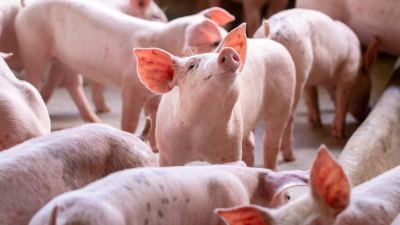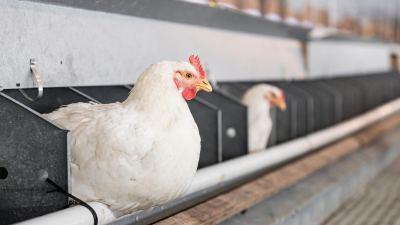Top tips for winter horse property preparation

Farmers and ranchers typically use late summer and early fall to do their prep work for winter. Horse owners should take note and do the same, as fall is the ideal time to tackle winter preparedness. Cooler temperatures are easier to work in and better for plants and crops to establish root systems. Plus, the timing is right to get a leg up on tasks that will make it easier to get through wintertime challenges.
Use this “to-do” list to help you coordinate beneficial fall activities, which will undoubtedly provide a more chore-efficient winter with less weather-related stress.
1. Apply a “green band-aid” to bare spots in pastures. Fall is the ideal time to fix bare spots by overseeding pastures (at least six weeks before the first hard frost, which for most of North America typically occurs from mid-September through mid-October). Warm fall soil encourages root growth, which will continue until the ground freezes. In areas with mild winters, roots may continue to grow all season. Once early spring rolls around, roots either begin new growth or continue growing at a faster rate, while also beginning top growth. When summer finally arrives, fall-planted grass is far better equipped to deal with heat and drought because of its well-established root system. By contrast, grass seed planted in the spring will get a much slower start due to the cooler soil temperatures.
Other good reasons to plant in the fall include dependable rainfall, cooler weather (which most grasses prefer), fewer pest and disease problems and less competition from weeds. Drier fall weather also makes it much easier to prepare soil than it would be in the springtime.
Encourage a thick, healthy stand of grass by overseeding with forage plant seed on existing pastures. Overseed areas that are thin or have bare spots.
Talk with local extension offices or conservation districts about ideal forage plants for your soil.
2. Plant trees and shrubs. Fall is also a great time to place native plants, which can be beneficial on a horse property. For example, native hedgerows can act as wind or dust barriers and provide an attractive visual boundary between neighboring uses. Native plants can act as mud managers alongside paddocks and confinement areas to help reduce flows, absorb water, and filter sediments and pollutants. Check with your local conservation district or Horses for Clean Water if you have any specific questions on this topic.
3. Provide shelter for your horse. Shelter requirements may vary depending on your specific horse and location. However, horses typically need a way to get out of driving rain and/or wind. They can usually regulate their own body temperature if allowed to do so. Your horse’s shelter doesn’t have to be complex. It can be as simple as a three-sided run-in shed, a stall with a paddock, or a shelterbelt of trees.
4. Bring in footing material for paddocks, confinement areas and other high-traffic areas. Now is the time to think about the sand or gravel you will need for footing in confinement and heavy use areas, such as in front of gates. These materials are easier to access in the fall before demand is high. Plus, it is easier for delivery trucks to back into paddocks and drive through pastures in the dry season rather than once these areas become slick and muddy during the rainy season. Put down 2 to 6 inches of material for each of these areas.
5. Begin a horse manure management program. If you don’t do so already, now is the time to start picking up manure on a regular basis. A horse creates 50 pounds of manure per day. When mixed with winter rain or melting snow, this quickly becomes 50 pounds per day of unsightly and potentially hazardous muck. All manure should be picked up at least every three days in stalls, paddocks, confinement areas and high traffic areas. Composting is a great way to manage manure and turn it into a valuable resource for your property.
6. Spread compost. Early fall is a great time to spread compost. Compost is a rich source of soil enhancement. It adds micro- and macro-nutrients and replenishes natural microbes, all of which improve the health of soil and plants. Spread compost in pastures during the growing season no more than one-half inch thick and no more than three to four inches per season in the same place. Check with your local conservation district for more advice and to ask if they have a manure spreader rental program.
7. Check gutters and downspouts. Roof runoff systems should be cleaned and repaired in the fall. Gutters and downspouts “keep clean rainwater clean” by diverting roof runoff away from your paddocks to areas where it won’t get contaminated with manure or create mud. Good areas to divert rainwater to include a grassy ditch, a dry rocky landscaping area, rain barrels, stock watering tanks, well-vegetated woods, or an unused portion of pasture. Doing this will greatly benefit you by reducing the amount of mud your horse spends the winter standing in. It will also make daily chores easier.
8. Reroute surface water runoff. Runoff from driveways, parking areas, and hillsides can add significantly to the problem of managing mud in confinement areas. Ditches, grassy swales, dry wells, water diversion bars, and culverts are all useful means for diverting water away from confinement areas and barns. It is considerably easier to build these now than during the next downpour.
9. Review equipment needs for daily chores. Having the right equipment for chores not only makes things more efficient but also ensures that you’ll be more likely to get those chores accomplished when it’s dark and cold. Consider purchasing a manure cart that’s easy to push and to dump into the compost pile, along with a new manure fork if necessary. The heavy-duty plastic-tined type with a bent edge is made specifically for cleaning horse stalls and paddocks. Wooden handles or ones wrapped with tennis grip tape (or even vet wrap) are easier — and warmer — to grip than metal handles.
10. Review lighting needs. In the winter, most feeding time is in the dark — either early morning or evening. Indoor as well as outdoor lighting will help immensely with chore efficiency. When you come home after work, do you have enough light to pick up manure and clean stalls and paddocks? When feeding, can you see the hay well enough to weigh it and be sure it is both green and mold-free? Solar lighting along walkways or drives makes nighttime walkways safer. Prepare now instead of waiting until temperatures are freezing and you’re trying to feed by cell phone flashlight.
11. Consider your emergency equipment needs. Do you have a headlamp flashlight that frees up your hands? Store several in easy-to-locate areas in the house and barn. Keep them charged or be sure to always have extra batteries on hand. How about fuel for generators, outdoor cook stoves or lanterns? Having a car cell phone charger on hand is also extremely important to power cell phones in case of a power outage. A cell phone with a dead battery and no way to recharge it is useless.
12. Set up a water supply that won’t freeze or get too cold during winter weather events. A horse drinks 8 to 12 gallons of water per day. Academic research shows horses prefer warm water, about 45–65 F. Horses drink less when water is icy cold, and studies show they cannot get enough moisture by simply eating snow. Inadequate water consumption can lead to colic, so it is very important to make sure your horses are drinking enough. On very cold days you can either break ice twice daily, consider getting a stock tank heater, or get a heated stall and/or muck bucket.
13. Develop a backup plan for watering your horses if you are concerned you might lose power to your private well. Water can be stored in rain barrels or garbage cans. Emergency officials generally recommend having a 3-day supply of water on hand, which for horses is a minimum of 30 gallons of water each.
14. Feed more hay. If the temperatures really drop, a horse must work harder to maintain its body temperature. The American Association of Equine Practitioners (AAEP) recommends increasing caloric intake by as much as 15–20% for every 10-degree drop in temperatures below 30 F. Hay (not grain) is the best choice for helping a horse generate body heat. Forages are digested in the large intestine by a process that generates body heat and raises the horse’s core temperature. Grain is digested in the stomach and small intestine, which creates much less heat. It is wise to provide plenty of good-quality hay during cold winter weather; free choice is best if possible.
15. Check your waterproof turnout horse blankets for rips or other necessary mending or washing so they are on hand and ready for use should you need them. Most horses don’t need to be blanketed since nature provides them with their own warm coat, but there may be circumstances when a waterproof turnout blanket would be helpful, such as in the instance of a cold, heavy downpour, or a polar vortex–type freeze, or if a horse should become hypothermic for health reasons.
16. Consider your own winter waterproof clothing needs. This is a fundamental yet often overlooked point. As a horse owner, you are likely to be working with horses in inclement weather for a significant amount of time. Invest in a good, waterproof jacket; calf-high, insulated mud boots; and waterproof, insulated gloves. These items will go a long way toward helping you stay ahead on winter chores and will be particularly beneficial if there’s a winter emergency. You are no good to your horses if you become hypothermic and in need of immediate medical attention.
17. Flood-proof your property. If you live in a flood-prone area or near a creek, river or wetlands, take time to review the high-water locations on your property. If it is difficult to visualize these, get help from your county or your local conservation district. Acquaint yourself with the historic high-water locations recorded for your property. If you live in an extremely flood-prone area (of which there are many), it may be wise to consider building a “critter pad.”
A critter pad is a large mound or small hill built out of dirt and fill material above the floodwater level. It is used to keep animals above a flood. Critter pads usually require special permitting and must be specifically engineered using approved fill material to ensure that they stand up to high traffic, heavy rains and high water volumes, all while remaining above flood levels. In some cases, funding or technical assistance may be available to help with the development of a critter pad. Contact your local conservation district, Natural Resources Conservation Service (NRCS) office or Federal Emergency Management Agency (FEMA) office sooner rather than later for assistance.
The dead of winter and the early spring are common times for damaging, dangerous storms in North America. Making chore efficiency updates on your horse property and organizing backup supplies now will prove helpful in getting through the most challenging time of the year for horse owners, and it may help you avoid disaster.















